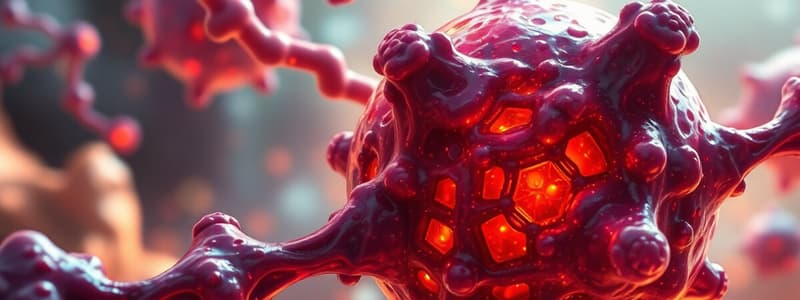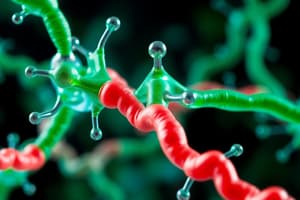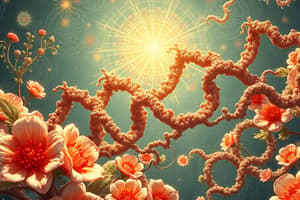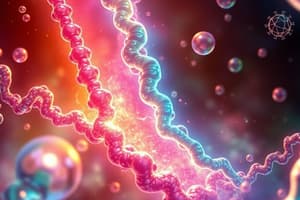Podcast
Questions and Answers
Enzyme catalysis accelerates reactions by primarily:
Enzyme catalysis accelerates reactions by primarily:
- Increasing the potential energy of the reactants.
- Increasing the kinetic energy of the products.
- Lowering the activation energy by stabilizing the transition state. (correct)
- Altering the equilibrium constant of the reaction.
Enzymes alter the overall free energy change (ΔG) of a reaction.
Enzymes alter the overall free energy change (ΔG) of a reaction.
False (B)
What term describes the non-protein components some enzymes require for activity?
What term describes the non-protein components some enzymes require for activity?
cofactors
The specific region of an enzyme that binds substrate is called the ________ site.
The specific region of an enzyme that binds substrate is called the ________ site.
The Michaelis constant (Km) is best described as:
The Michaelis constant (Km) is best described as:
A low Km indicates that the enzyme has a weak affinity for its substrate.
A low Km indicates that the enzyme has a weak affinity for its substrate.
What is the term for the unstable, high-energy arrangement of atoms during a reaction that enzymes help to stabilize?
What is the term for the unstable, high-energy arrangement of atoms during a reaction that enzymes help to stabilize?
Enzymes stabilize the ________ state, thus lowering the activation energy required for a reaction.
Enzymes stabilize the ________ state, thus lowering the activation energy required for a reaction.
Enzymes can stabilize the transition state by:
Enzymes can stabilize the transition state by:
Enzymes are consumed during the reactions they catalyze.
Enzymes are consumed during the reactions they catalyze.
What is the effect of an enzyme on the forward and reverse reaction rates?
What is the effect of an enzyme on the forward and reverse reaction rates?
An enzyme increases the rate of the reaction by __________ the activation energy.
An enzyme increases the rate of the reaction by __________ the activation energy.
Which of the following mechanisms does NOT contribute to the way enzymes catalyze reactions?
Which of the following mechanisms does NOT contribute to the way enzymes catalyze reactions?
Cofactors can be either organic molecules or metal ions.
Cofactors can be either organic molecules or metal ions.
What is the term for organic cofactors, often derived from vitamins, that assist in enzyme-catalyzed reactions?
What is the term for organic cofactors, often derived from vitamins, that assist in enzyme-catalyzed reactions?
Enzymes that perform multiple sub-reactions at distinct active sites may utilize molecular _________ to direct intermediate products.
Enzymes that perform multiple sub-reactions at distinct active sites may utilize molecular _________ to direct intermediate products.
What is the main function of molecular tunnels in some enzymes?
What is the main function of molecular tunnels in some enzymes?
Multi-enzyme complexes ensure that metabolic pathways occur randomly without specific order.
Multi-enzyme complexes ensure that metabolic pathways occur randomly without specific order.
What is the term for a series of enzymes organized together to catalyze a sequence of reactions in a metabolic pathway?
What is the term for a series of enzymes organized together to catalyze a sequence of reactions in a metabolic pathway?
Enzymes are tightly ______ to respond to changing cellular conditions.
Enzymes are tightly ______ to respond to changing cellular conditions.
What is the primary purpose of tight regulation of enzymes?
What is the primary purpose of tight regulation of enzymes?
Feedback inhibition involves a downstream product regulating an upstream enzyme.
Feedback inhibition involves a downstream product regulating an upstream enzyme.
What type of control is exemplified when high levels of ATP inhibit phosphofructokinase in glycolysis?
What type of control is exemplified when high levels of ATP inhibit phosphofructokinase in glycolysis?
In ________ inhibition, a downstream product regulates an upstream enzyme in a metabolic pathway.
In ________ inhibition, a downstream product regulates an upstream enzyme in a metabolic pathway.
Irreversible enzyme inhibitors typically function by:
Irreversible enzyme inhibitors typically function by:
Competitive inhibitors bind to the enzyme away from the active site, causing a conformational change that reduces enzyme activity.
Competitive inhibitors bind to the enzyme away from the active site, causing a conformational change that reduces enzyme activity.
What distinguishes competitive and non-competitive inhibitors in terms of their binding site on the enzyme?
What distinguishes competitive and non-competitive inhibitors in terms of their binding site on the enzyme?
A ________ inhibitor binds to the active site of an enzyme, preventing substrate binding.
A ________ inhibitor binds to the active site of an enzyme, preventing substrate binding.
Allosteric regulators bind to an enzyme:
Allosteric regulators bind to an enzyme:
Allosteric regulation always inhibits enzyme activity.
Allosteric regulation always inhibits enzyme activity.
How do enzymes increase the rate of reaction without altering the equilibrium?
How do enzymes increase the rate of reaction without altering the equilibrium?
Explain the relationship between the active site of an enzyme and its substrate specificity.
Explain the relationship between the active site of an enzyme and its substrate specificity.
Differentiate between cofactors and coenzymes and give an example of each.
Differentiate between cofactors and coenzymes and give an example of each.
Describe how enzymes stabilize the transition state and why this is important for catalysis.
Describe how enzymes stabilize the transition state and why this is important for catalysis.
Explain the concept of 'molecular tunnels' in enzymes and their advantage in catalysis.
Explain the concept of 'molecular tunnels' in enzymes and their advantage in catalysis.
How does phosphorylation regulate enzyme activity, and why is this a useful regulatory mechanism?
How does phosphorylation regulate enzyme activity, and why is this a useful regulatory mechanism?
Explain how feedback inhibition regulates metabolic pathways.
Explain how feedback inhibition regulates metabolic pathways.
Describe the difference between competitive and non-competitive enzyme inhibitors.
Describe the difference between competitive and non-competitive enzyme inhibitors.
How do irreversible inhibitors affect enzyme function, and give an example?
How do irreversible inhibitors affect enzyme function, and give an example?
Explain the significance of $K_m$ in enzyme kinetics.
Explain the significance of $K_m$ in enzyme kinetics.
What is $V_{max}$ and what factors can affect it?
What is $V_{max}$ and what factors can affect it?
Describe the role of allosteric regulation in enzyme activity.
Describe the role of allosteric regulation in enzyme activity.
What is the significance of multi-enzyme complexes in metabolic pathways?
What is the significance of multi-enzyme complexes in metabolic pathways?
Explain the difference between an enzyme's active site and an allosteric site.
Explain the difference between an enzyme's active site and an allosteric site.
How do enzymes increase the rate of reaction regarding the diagram showing enzyme catalyzed reaction pathway vs. uncatalyzed reaction pathway?
How do enzymes increase the rate of reaction regarding the diagram showing enzyme catalyzed reaction pathway vs. uncatalyzed reaction pathway?
What is the difference between covalent modifications and allosteric regulations?
What is the difference between covalent modifications and allosteric regulations?
What is the role of the enzyme when it catalyzes the forward and reversible reactions?
What is the role of the enzyme when it catalyzes the forward and reversible reactions?
Explain the relation between enzyme and prosthetic groups vs. cofactors.
Explain the relation between enzyme and prosthetic groups vs. cofactors.
In the multi-enzyme complex diagram, the product of the first enzyme is passed on to what?
In the multi-enzyme complex diagram, the product of the first enzyme is passed on to what?
Explain how enzymes play the role of molecular integrators.
Explain how enzymes play the role of molecular integrators.
How do enzymes stabilize transition states based on the shape?
How do enzymes stabilize transition states based on the shape?
Explain how enzymes function by stabilizing specific transition states of the substrate.
Explain how enzymes function by stabilizing specific transition states of the substrate.
How does enzyme binding adjust the geometry of reactants?
How does enzyme binding adjust the geometry of reactants?
What are the key features of an enzyme?
What are the key features of an enzyme?
Explain the benefit of using molecular tunnels in enzymes
Explain the benefit of using molecular tunnels in enzymes
What is the impact of covalent modification of an enzyme?
What is the impact of covalent modification of an enzyme?
What is the influence of non-substrate ligands on enzyme?
What is the influence of non-substrate ligands on enzyme?
Flashcards
What are Enzymes?
What are Enzymes?
Proteins that speed up cellular reactions without being altered themselves, enabling life processes.
How do enzymes work?
How do enzymes work?
Enzymes stabilize the transition state of a reaction, lowering the activation energy needed for the reaction to proceed.
What is the active site?
What is the active site?
The specific region of an enzyme where the substrate binds and catalysis occurs.
What is the Enzyme-Substrate Complex?
What is the Enzyme-Substrate Complex?
Signup and view all the flashcards
What is Km?
What is Km?
Signup and view all the flashcards
What is Vmax?
What is Vmax?
Signup and view all the flashcards
What are Cofactors and Coenzymes?
What are Cofactors and Coenzymes?
Signup and view all the flashcards
What are Molecular Tunnels?
What are Molecular Tunnels?
Signup and view all the flashcards
Benefits of Molecular Tunnels?
Benefits of Molecular Tunnels?
Signup and view all the flashcards
What are Multi-Enzyme Complexes?
What are Multi-Enzyme Complexes?
Signup and view all the flashcards
What is Feedback Control?
What is Feedback Control?
Signup and view all the flashcards
What are Enzyme Inhibitors?
What are Enzyme Inhibitors?
Signup and view all the flashcards
What are Irreversible Inhibitors?
What are Irreversible Inhibitors?
Signup and view all the flashcards
What are Competitive Inhibitors?
What are Competitive Inhibitors?
Signup and view all the flashcards
What are Non-competitive Inhibitors?
What are Non-competitive Inhibitors?
Signup and view all the flashcards
What is Covalent Modification?
What is Covalent Modification?
Signup and view all the flashcards
What is Allosteric Regulation?
What is Allosteric Regulation?
Signup and view all the flashcards
Transition State
Transition State
Signup and view all the flashcards
Enzyme Catalysis Stabilization
Enzyme Catalysis Stabilization
Signup and view all the flashcards
Enzymes in Small amounts?
Enzymes in Small amounts?
Signup and view all the flashcards
What reactions do enzymes catalyze?
What reactions do enzymes catalyze?
Signup and view all the flashcards
Enzyme Function
Enzyme Function
Signup and view all the flashcards
Enzyme-Product Complex
Enzyme-Product Complex
Signup and view all the flashcards
Vmax Definition
Vmax Definition
Signup and view all the flashcards
What happens an enzyme had lower Km?
What happens an enzyme had lower Km?
Signup and view all the flashcards
Enzyme Binding
Enzyme Binding
Signup and view all the flashcards
Prosthetic Groups
Prosthetic Groups
Signup and view all the flashcards
Enzymes
Enzymes
Signup and view all the flashcards
Metabolic pathways
Metabolic pathways
Signup and view all the flashcards
Why are enzymes tightly regulated?
Why are enzymes tightly regulated?
Signup and view all the flashcards
irreversible inhibitors
irreversible inhibitors
Signup and view all the flashcards
Covalent Modification
Covalent Modification
Signup and view all the flashcards
What is an allosteric regulator?
What is an allosteric regulator?
Signup and view all the flashcards
What is the transition state of a reaction?
What is the transition state of a reaction?
Signup and view all the flashcards
What are enzyme molecular tunnels?
What are enzyme molecular tunnels?
Signup and view all the flashcards
What is feedback inhibition?
What is feedback inhibition?
Signup and view all the flashcards
Non-competitive inhibitors
Non-competitive inhibitors
Signup and view all the flashcards
What do protein kinases do?
What do protein kinases do?
Signup and view all the flashcards
What is conformational change in enzymes?
What is conformational change in enzymes?
Signup and view all the flashcards
Example of feedback control?
Example of feedback control?
Signup and view all the flashcards
How do enzymes catalyze reactions?
How do enzymes catalyze reactions?
Signup and view all the flashcards
Give an example of irreversible inhibitors?
Give an example of irreversible inhibitors?
Signup and view all the flashcards
Study Notes
- Enzyme catalysis stabilizes the reaction's transition state.
- Some enzymes require non-protein components (cofactors or prosthetic groups) for function.
- Enzymes are highly regulated by covalent modification and binding of non-substrate ligands (allosteric regulation).
Enzymes
- Enzymes are catalytic proteins that speed up cellular reactions.
- Enzymes do not alter the free energy change (ΔG) of a reaction.
- Enzymes cannot make a thermodynamically unfavorable reaction occur spontaneously.
- Enzymes cannot alter reactant or product concentrations at equilibrium.
- Enzymes do not extract more useful energy per mole of reactants, they only accelerate the process.
- Enzymes determine nearly all chemical transformations involved in making or breaking covalent bonds in cells.
- As catalysts, enzymes are required in small amounts.
- Enzymes must remain unchanged after a reaction to cycle back and bind more substrate.
- Enzymes catalyze forward and reverse reactions equally.
- Enzymes can increase reaction rates by 10^8 to 10^12-fold.
- Enzyme function begins with substrate binding at a stereo-specific active site, forming an enzyme-substrate complex.
- The active site has a 3-D shape that is particular to the substrate.
- After substrate binding, the substrate is chemically converted to product, forming an enzyme-product complex.
- The product is released, and the enzyme can bind another substrate molecule.
- Enzymes kinetics describe the rates of enzymatic reactions.
Vmax and Km
- Vmax is the maximum rate when the enzyme is saturated with substrate.
- Km (Michaelis constant) is approximately equal to the dissociation constant for the enzyme-substrate complex.
- A low Km indicates a high affinity of the enzyme for its substrate.
- The Km value of an enzyme usually lies within its substrate's natural concentration range.
- If the Km of an enzyme decreases, the binding interaction between the enzyme and substrate becomes stronger.
- A reduced Km also indicates that less substrate is required to half-saturate the enzyme.
Enzyme Binding
- Substrate molecules pass through intermediate states.
- The 3D geometry of reactants needs adjustment for optimal interaction.
- Electrons among reacting atoms become redistributed.
Transition States
- The transition state is an intermediate form between reactants and products, with a specific structure.
- Enzymes stabilize transition states, thus lowering the activation energy.
- As substrates react, they go through a state with a higher energy level.
- The energy needed to reach this state is the activation energy.
- Enzymes achieve transition state stabilization through various mechanisms.
- Enzymes bind two substrate molecules and orient them to encourage a reaction.
- Enzymes rearrange electrons in the substrate after binding.
- Rearranging electrons in the substrate creates partial negative and positive charges that favor a reaction.
- Enzymes strain the bound substrate molecule, forcing it toward a transition state.
Prosthetic Groups and Cofactors
- Prosthetic groups are non-protein molecules that aid in protein function.
- Prosthetic groups can be covalently or non-covalently bound by a protein.
- Hemoglobin uses heme as a prosthetic group for oxygen transport.
- Enzyme prosthetic groups are referred to as cofactors.
- Magnesium (Mg2+) is a critical cofactor for enzymes that join or cleave nucleic acids.
- Organic cofactors are often called coenzymes, such as coenzyme A (CoA).
- Vitamins frequently act as coenzymes or their precursors.
Molecular Tunnels
- Some enzymes perform multiple sub-reactions at distinct active sites.
- The enzyme's structure may act as tunnels to direct intermediate products from one active site to the next.
- The intermediates never leave the enzyme.
- Molecular Tunnels prevent diffusion of intermediates and decomposition of unstable molecules, speeding up reaction rates.
- Carbamoyl phosphate synthetase has 3 active sites connected by molecular tunnels.
Multi-Enzyme Complexes
- Most metabolic pathways require reactions in a specific, highly regulated order.
- Enzymes in a pathway can be organized into higher-order, multi-enzyme complexes.
- The product of the first enzyme is passed to the second enzyme as its substrate, and so on.
- Multi-enzyme complexes prevent product diffusion and allow for coordinated regulation of the pathway.
Enzyme Regulation
- Enzymes must respond rapidly to changing cellular conditions.
- Many enzymes are not constitutively active and are turned on/off when needed.
- Regulation of key enzymes involves multiple inputs, akin to molecular integrators.
- Feedback control regulates upstream enzymes: a downstream product regulates an upstream enzyme in a given pathway.
- When product concentrations reach sufficient levels, further production is halted via negative regulation.
Enzyme Inhibitors
- Enzyme inhibitors can be reversible or irreversible.
Irreversible Inhibitors
- Irreversible inhibitors covalently bind to an amino acid residue in the active site.
- Irreversible inhibitors usually lower Vmax by effectively inactivating and "removing" active enzyme molecules.
- Irreversible inhibitors are rare in nature but common in industry.
- Aspirin inhibits the enzymes COX-1 and COX-2 by acetylating a serine in the active site.
Reversible Inhibitors
- Reversible inhibitors are common in nature, and can be either competitive or non-competitive.
- Competitive inhibitors reversibly bind to the active site and compete with the substrate.
- Competitive inhibition can be displaced by high substrate concentrations.
- Competitive inhibitors increase Km, lowering the apparent "affinity," but they do not reduce Vmax.
- Non-competitive inhibitors reversibly bind away from the active site.
- Binding away from the active site causes a change in enzyme structure that lowers catalytic efficiency.
- Non-competitive inhibitors lower Vmax.
- Non-competitive inhibitors do not increase Km, and do not affect substrate binding.
Regulation of Enzyme Function by Covalent Modification
- Phosphorylation and dephosphorylation are common covalent modifications added to proteins to regulate activity.
- Phosphorylation allows for rapid, reversible regulation coded by a short (4-6) linear amino acid sequence.
Regulation of Enzyme Function: Allosteric
- Allosteric regulators are regulatory molecules with a unique shape, distinct from the enzyme's natural substrate.
- Allosteric regulators bind at a site away from the catalytic site.
- Binding of a molecule at one region of an enzyme influences the binding of another molecule to a different region via a conformational change in protein structure.
- The allosteric site is part of the same protein chain as the active site or in a "regulatory subunit".
- A small, allosteric molecule binds to a regulatory site.
- Binding results in a change in the conformation of the catalytic site.
- Conformational changes in the catalytic site can either activate (promote substrate binding/catalysis) or inhibit (prevent substrate binding/catalysis).
- Allosteric inhibitors possess qualities of competitive (affect substrate binding) and non-competitive (affect catalysis) inhibition.
Studying That Suits You
Use AI to generate personalized quizzes and flashcards to suit your learning preferences.




